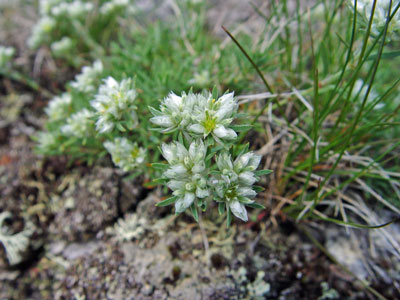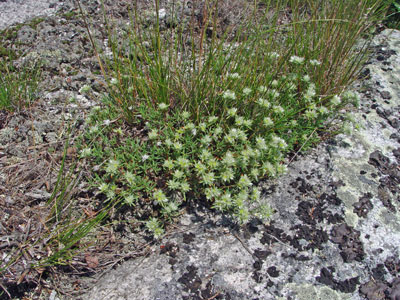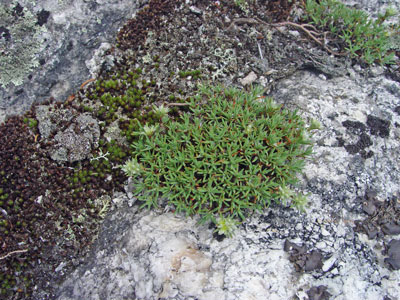DACF Home → Bureaus & Programs → Maine Natural Areas Program → Communities, Plants, and Animals → Rare Plants → Paronychia argyrocoma

Paronychia argyrocoma (Michx.) Nutt.
Silverling
- State Rank: S1
- Global Rank: G4
- State Status: Threatened
Habitat: Bare granitic slopes, mountain tops, or sandy river banks. [Alpine or subalpine (non-forested, upland); Non-tidal rivershore (non-forested, seasonally wet)]
Range: Maine, New Hampshire, near Newburyport, Massachusetts. Mountains of Georgia, Tennessee, to Virginia and West Virginia.
Aids to Identification: Silverling is a low-growing, tufted plant; its linear, oppositely arranged leaves form mats 4-15 cm across. The small, white flowers, clustered at the tops of stems, are almost hidden by the conspicuous silvery-hairy bracts that give the plant its common name.

Ecological characteristics: Paronychia argyrocoma grows on ledges on bare gravel with little or no organic matter or soil, where few other vascular species venture except Minuartia glabra. Its habitat on exposed mountain tops is frequently traversed by hiking trails. Plants in such sites show evidence of damage by trampling and are also particularly subject to collecting. A single Massachusetts population has fluctuated from 196 colonies in 1945, to 56 in 1978, back to 104 colonies in 1980. The cause of this fluctuation is unknown. Many Maine populations are extremely small, down to single individuals at a few sites, which increases its vulnerability.
Phenology: Perennial; in Maine, flowers late June to July, seeds mature late summer.
Family: Caryophyllaceae
Synonyms: Paronychia argyrocoma ssp. albimontana (Fern.) Maguire; Paronychia argyrocoma var. albimontana Fern.

Known Distribution in Maine: This rare plant has been documented from a total of 8 town(s) in the following county(ies): Franklin, Oxford.
Reason(s) for rarity: The New England populations of silverling, when considered a rarity separate from the typical species, were considered as possible threatened species by the U.S. Fish & Wildlife Service. Further taxonomic review of the species seems to indicate that the northern populations are simply at one extreme of a clinal, geographic continuum of variation in the population and therefore should not be given a distinct taxonomic status. Since the southern populations are vigorous and thriving, the species as a whole cannot be considered threatened. However, because of their disjunct location and extreme rarity within the region, Maine populations still merit consideration as rarities significant at the New England level.
Conservation considerations: Heavy recreational use of the sandy habitats where this occurs has degraded the habitat in some locations and continued heavy use will be detrimental to the plant populations. On some rocky habitats, this species has declined apparently due to heavy hiking pressure.
For more information, see the Native Plant Trust's Conservation Plan for Paronychia argyrocoma.